If you’re looking for the best Ethernet backhaul mesh Wi-Fi kits of 2025, I recommend options like TP-Link Deco X55, Deco XE75, and NETGEAR Nighthawk systems, which cover large spaces with reliable wired links. Systems supporting MoCA adapters, such as Hitron HTEM5, also enhance connectivity without new cabling. These kits’re designed for seamless, high-speed connections, ideal for demanding environments. Keep exploring to find the perfect setup that fits your needs perfectly.
Key Takeaways
- Prioritize mesh kits with multiple Gigabit Ethernet ports for reliable wired backhaul support.
- Look for systems supporting Wi-Fi 6 or Wi-Fi 7 for faster, more efficient connectivity.
- Choose models with expandable nodes to ensure coverage in large or multi-floor spaces.
- Ensure compatibility with existing infrastructure, such as coax via MoCA adapters, for seamless integration.
- Consider security features and user-friendly management apps for optimal network control and security.
TP-Link Deco X55 WiFi 6 Mesh System (3-Pack)
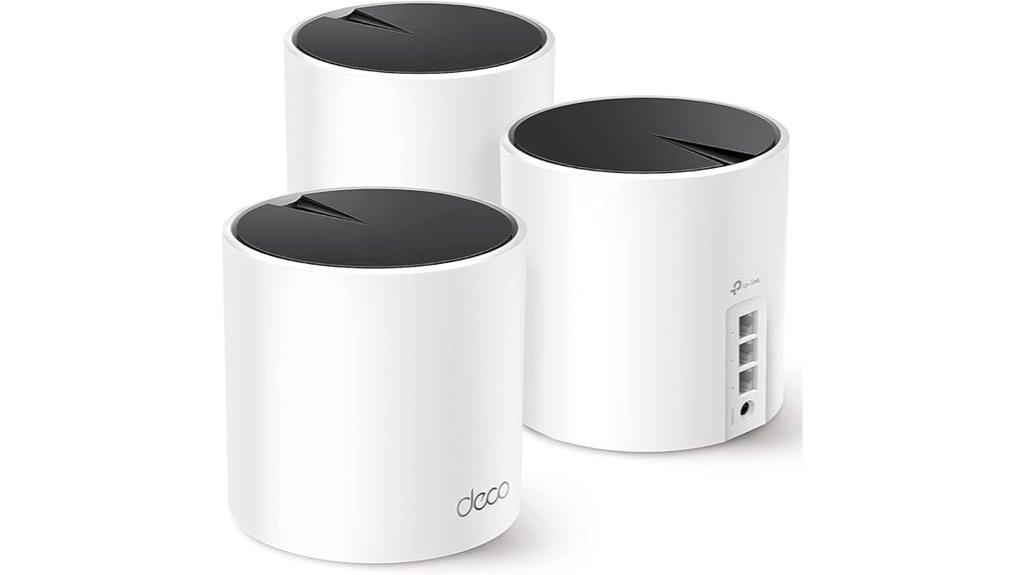
If you’re looking to eliminate dead zones and guarantee reliable Wi-Fi coverage across a large home, the TP-Link Deco X55 WiFi 6 Mesh System (3-Pack) is an excellent choice. Covering up to 6,500 sq.ft., it replaces traditional routers and extenders with seamless Wi-Fi 6 performance. Supporting Ethernet backhaul, each unit has 3 Gigabit Ethernet ports for wired connections. It connects up to 150 devices, ensuring fast, stable internet throughout your space. The AI-driven mesh technology adapts to your environment, optimizing speeds. Easy to set up via the Deco app, it’s compatible with most ISPs and backed by a 2-year warranty and 24/7 support.
Best For: households seeking extensive, reliable Wi-Fi coverage with fast speeds and easy setup for large areas up to 6,500 sq.ft.
Pros:
- Seamless coverage up to 6,500 sq.ft. with mesh technology, eliminating dead zones
- Supports up to 150 devices with high-speed Wi-Fi 6 AX3000 performance
- Easy setup via the Deco app with remote management and built-in security features
Cons:
- May be more expensive than traditional routers or extenders for smaller spaces
- Requires compatible modem and ISP support, which could involve additional setup steps
- The 3-pack may be more than needed for smaller homes or apartments
TP-Link Deco WiFi 6 Mesh System (Deco X20)

Looking for a reliable Wi-Fi solution that can handle a large number of devices without sacrificing speed? The TP-Link Deco WiFi 6 Mesh System (Deco X20) is an excellent choice. It uses next-gen Wi-Fi 6 AX1800 tech, covering up to 5800 sq.ft. with three units. It supports wired Ethernet backhaul, with each unit featuring two Gigabit ports for faster, more stable connections. Capable of connecting up to 150 devices, it reduces lag and improves stability for streaming, gaming, and calls. The setup is straightforward via the Deco app, and it’s compatible with major ISPs. Plus, its advanced features like Beamforming and seamless roaming make it a top contender for large homes.
Best For: households or small offices needing high-capacity, reliable Wi-Fi coverage across large areas with multiple devices.
Pros:
- Supports up to 150 devices simultaneously, ideal for dense environments.
- Seamless roaming and advanced signal technologies like Beamforming improve stability and coverage.
- Easy setup and management via the Deco app, compatible with major ISPs and voice commands.
Cons:
- Requires a modem for most internet plans, adding to initial setup costs.
- Slightly larger footprint for each unit, which may be less discreet in some spaces.
- No built-in battery or portable design, limiting use to fixed locations.
TP-Link Deco XE75 WiFi 6E Mesh System (3-Pack)

The TP-Link Deco XE75 WiFi 6E Mesh System is an excellent choice for large households that need seamless, high-speed internet coverage across extensive spaces. Covering up to 7,200 sq.ft, it replaces traditional routers and extenders with three units, supporting speeds up to 5,400 Mbps for 200 devices. Its tri-band operation includes a dedicated 6 GHz band, offering interference-free performance and stable backhaul links. Thanks to AI-driven mesh technology, it automatically optimizes connections and eliminates dead zones. Easy to set up via the Deco app, it also provides robust security features, including TP-Link HomeShield, making it a reliable, future-proof solution for demanding, connected homes.
Best For: households and large homes requiring high-speed, seamless WiFi coverage with advanced security and easy management.
Pros:
- Covers up to 7,200 sq.ft with three units, ideal for large spaces
- Supports WiFi speeds up to 5,400 Mbps for multiple devices simultaneously
- Features AI-driven mesh technology for automatic optimization and elimination of dead zones
Cons:
- Requires a compatible modem and internet service provider; setup may be complex for some users
- Higher price point compared to basic routers or extenders
- The size and weight of units may be less suitable for small spaces or wall mounting
TP-Link Deco BE23 Dual-Band Mesh Wi-Fi System (3-Pack)

For large homes or multi-floor setups, the TP-Link Deco BE23 Dual-Band Mesh Wi-Fi System (3-Pack) offers reliable coverage and high-speed connections. It leverages Wi-Fi 7 with Multi-Link Operation (MLO), delivering speeds up to 3.6 Gbps and supporting over 150 devices simultaneously. With four high-gain antennas per node, beamforming, and advanced features like OFDMA, it guarantees stable, fast connections for streaming, gaming, and smart home devices. The system supports wired backhaul via dual 2.5 Gbps ports, enhancing stability. Easy to set up and manage through the Deco app, it combines future-proof technology with robust security, making it ideal for large or multi-story homes.
Best For: households with large, multi-floor spaces or numerous smart devices seeking fast, reliable Wi-Fi 7 coverage and seamless connectivity.
Pros:
- Supports Wi-Fi 7 with speeds up to 3.6 Gbps and over 150 connected devices
- Covers large areas up to 6,500 sq. ft. with a 3-pack setup
- Wired backhaul with dual 2.5 Gbps ports for enhanced stability and performance
Cons:
- Initial setup may encounter minor app connectivity issues
- Limited customization options for LAN IP address configuration
- No dedicated LAN port for each device, relying on mesh setup for wired connections
Hitron HTEM5 MoCA 2.5 Adapter Kit (2-Pack)

If your home is wired for cable TV and you need a reliable, high-speed wired connection, the Hitron HTEM5 MoCA 2.5 Adapter Kit (2-Pack) is an excellent choice. It transforms existing coax outlets into high-speed Ethernet links supporting up to 2.5Gbps, ideal for mesh WiFi backhaul, streaming, gaming, and smart home devices with ultra-low 3ms latency. Easy to install with plug-and-play setup, it works with routers lacking MoCA built-in by adding adapters. Just confirm your coax wiring uses compatible splitters and proper connections. This kit provides a stable, wired backbone without extra wiring or drilling, boosting your network’s speed and reliability effortlessly.
Best For: Homeowners with cable TV wiring seeking a reliable, high-speed wired Ethernet solution to improve streaming, gaming, and smart home device connectivity.
Pros:
- Easy plug-and-play installation with minimal setup required
- Supports high-speed data transfer up to 2.5Gbps with ultra-low 3ms latency
- Compatible with existing coax wiring, enhancing network stability without additional wiring
Cons:
- Not compatible with satellite TV systems like DirecTV or DISH
- May require MoCA-compatible splitters for optimal performance with certain routers
- Limited to homes wired for cable TV; unsuitable for homes without coax wiring
TP-Link Deco S4 Mesh WiFi System (3-Pack)

With its support for wired Ethernet backhaul and multiple Gigabit ports on each unit, the TP-Link Deco S4 Mesh WiFi System (3-Pack) is an excellent choice for large homes or properties with dense walls. Covering up to 5,500 sq.ft., it replaces traditional routers and extenders, offering seamless coverage and strong signals in all directions. Each unit supports up to 100 devices and can function as a router, ensuring reliable, high-speed connectivity. Easy to set up via the Deco app, it efficiently handles demanding environments, providing stable WiFi for streaming, gaming, and multiple users without dead zones or lag.
Best For: households with large, multi-room spaces and dense walls that need reliable, extensive WiFi coverage with easy setup.
Pros:
- Seamless coverage up to 5,500 sq.ft. with mesh technology, eliminating dead zones.
- Supports wired Ethernet backhaul and multiple Gigabit ports for high-speed wired connections.
- Easy setup and management via the Deco app, compatible with major ISPs and smart home systems like Alexa.
Cons:
- Limited advanced configuration options for power users.
- Occasional firmware update issues reported by some users.
- Basic app interface compared to higher-end routers, with fewer customization features.
NETGEAR Orbi WiFi 6 Mesh System (RBK754P)
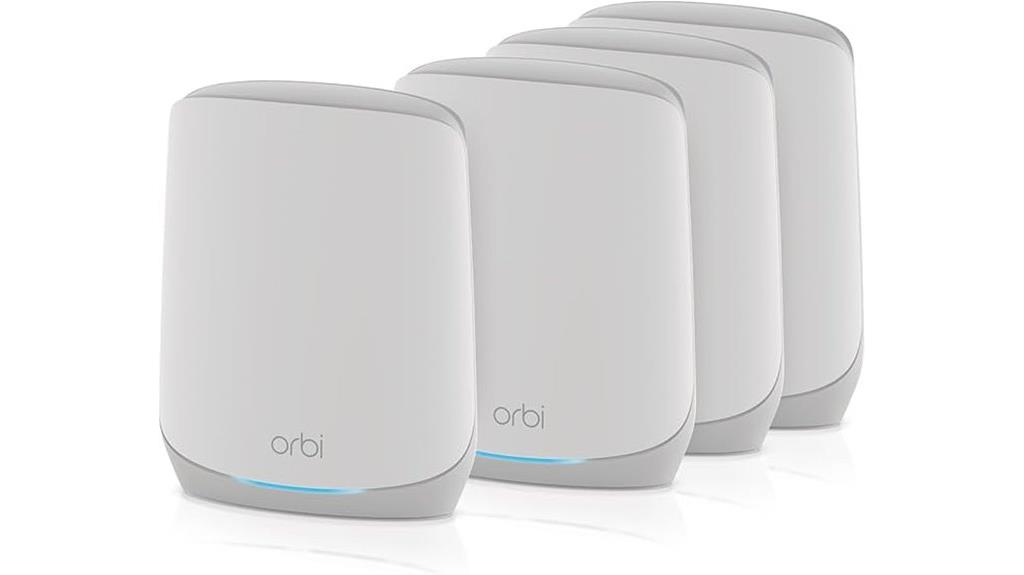
The NETGEAR Orbi WiFi 6 Mesh System (RBK754P) is the ideal choice for larger households or small offices that need reliable, high-speed internet across extensive spaces. Covering up to 10,000 sq. ft., it supports up to 75 devices simultaneously, ensuring seamless connectivity for multiple users. With AX5200 gigabit speeds and WiFi 6 technology, it’s perfect for streaming, gaming, and web conferencing. It connects directly to your existing modem, replacing your router, and offers wired options with Ethernet ports on each device. Easy to set up and manage via the Orbi app, it also includes robust security features to keep your network safe.
Best For: households or small offices requiring extensive, reliable high-speed WiFi coverage for multiple devices across large spaces.
Pros:
- Covers up to 10,000 sq. ft. and supports up to 75 devices simultaneously.
- Utilizes WiFi 6 technology for faster speeds and better performance with multiple devices.
- Easy to set up and manage via the Orbi app, with built-in security features including NETGEAR Armor.
Cons:
- May be more expensive than smaller or less feature-rich WiFi systems.
- Requires existing modem and may need additional satellites for optimal coverage in very large or complex layouts.
- Limited to U.S. use, which could restrict availability or support in other regions.
DBIT AX1500 WiFi 6 Mesh Wi-Fi System (3-Pack)
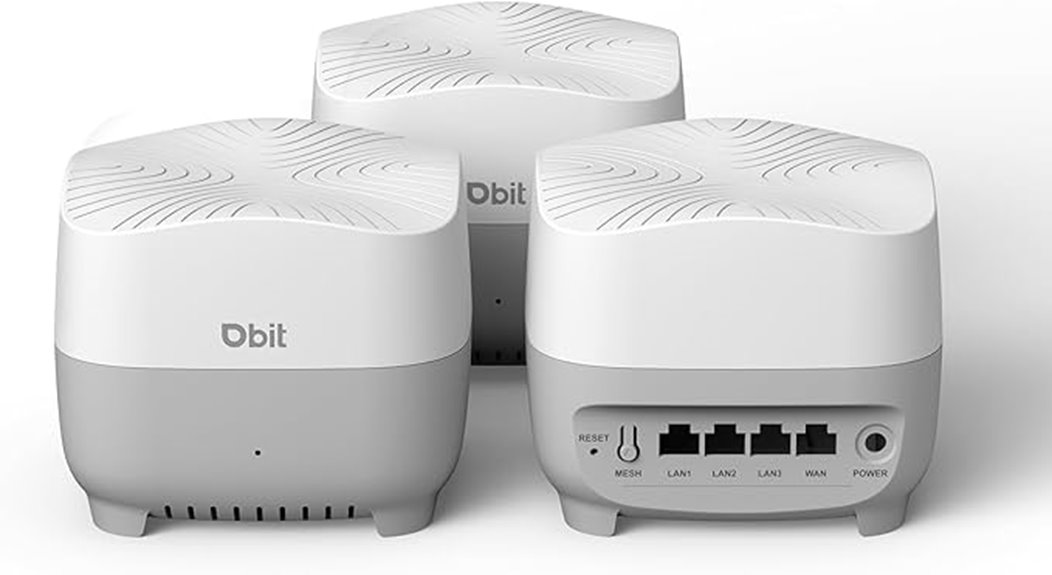
For large homes or complex layouts needing reliable, high-speed connectivity, the DBIT AX1500 WiFi 6 Mesh System (3-Pack) stands out as an excellent choice. It offers seamless coverage up to 5,600 sq ft, replacing traditional routers and extenders while supporting up to 120 devices simultaneously. With speeds up to 1500Mbps, it handles streaming, gaming, and video calls effortlessly. Each node features four Gigabit Ethernet ports for wired connections. Built-in WPA3 encryption guarantees security, and the system’s smart roaming keeps devices connected smoothly. Easy to set up via the app or web interface, it’s perfect for those seeking a robust, user-friendly mesh Wi-Fi solution.
Best For: large households or multi-story homes needing reliable, high-speed Wi-Fi coverage and support for numerous devices simultaneously.
Pros:
- Seamless whole-home coverage up to 5,600 sq ft with mesh technology
- Supports up to 120 devices, ideal for busy households with multiple gadgets
- Equipped with Gigabit Ethernet ports on each node for wired device connections
Cons:
- First available date listed as June 17, 2025, which may be an error or a future release date
- Slightly higher price point compared to basic routers or extenders
- Requires a compatible app or web interface for setup and management, which might be complex for some users
ASUS 2.5Gbps Ethernet Over Coax Adapter Starter Kit (2 Pack)

If you’re looking to extend your Wi-Fi coverage using existing coaxial wiring, the ASUS 2.5Gbps Ethernet Over Coax Adapter Starter Kit is an excellent choice. This two-pack leverages MoCA 2.5 technology to deliver up to 2.5Gbps speeds, ensuring a reliable wired backhaul. Its wall-mountable, eco-friendly design makes installation easy and environmentally conscious. Compatible with active coax connections, it resists interference and works well alongside cable modems. The band mode switch optimizes connection quality, minimizing disruptions. With simple security features and a solid customer rating, it’s a practical solution for creating a stable, high-speed mesh network without running new cables.
Best For: households seeking to enhance their Wi-Fi coverage and network stability using existing coaxial wiring for high-speed wired backhaul.
Pros:
- Leverages existing coaxial wiring to avoid new cable installation.
- Supports MoCA 2.5 standard with speeds up to 2.5Gbps for fast, reliable connections.
- Eco-friendly, wall-mountable design with simple security features and interference resistance.
Cons:
- Actual network performance can vary depending on environmental and network conditions.
- Requires active coaxial connections; incompatible with inactive or damaged lines.
- Limited to use within homes that have suitable coaxial wiring and active connections.
Tenda AX1500 Mesh WiFi 6 System Nova MX3

Designed for large homes with demanding connectivity needs, the Tenda AX1500 Mesh WiFi 6 System Nova MX3 offers extensive coverage and high-speed performance. This 3-pack covers up to 3,500 sq.ft., replacing traditional routers and eliminating dead zones. It delivers speeds up to 1.5 Gbps with dual-band Wi-Fi 6, supporting smooth streaming, gaming, and downloads. Its MU-MIMO and OFDMA tech handle over 80 devices simultaneously with minimal lag. Setup is straightforward via the Tenda app or web GUI, and the mesh network guarantees seamless connectivity throughout your home. Overall, it provides reliable, high-capacity Wi-Fi tailored for large spaces.
Best For: households with large living spaces and numerous devices seeking seamless, high-speed Wi-Fi coverage and easy management.
Pros:
- Extensive coverage up to 3,500 sq.ft. with a 3-pack mesh system
- Supports speeds up to 1.5 Gbps, ideal for streaming, gaming, and downloads
- Easy setup and management via Tenda app or web GUI, with simple mesh integration
Cons:
- May be more expensive than traditional single-router solutions
- Requires compatible devices to fully utilize Wi-Fi 6 features
- Limited detailed advanced configuration options for tech-savvy users
WAVLINK AX3000 WiFi 6 Mesh System (3 Pack)
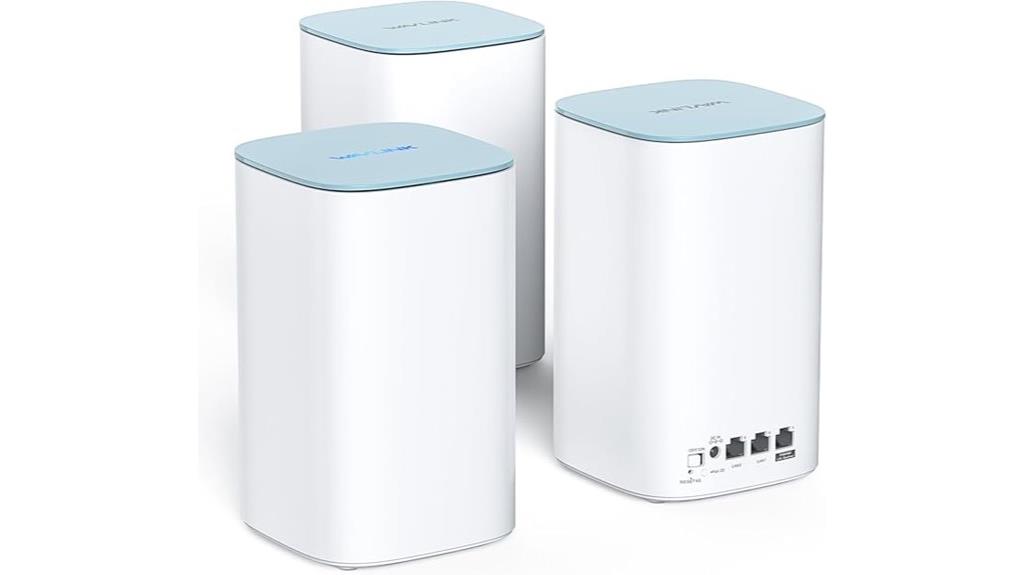
The WAVLINK AX3000 WiFi 6 Mesh System (3 Pack) is an excellent choice for large homes or offices that need reliable, high-speed coverage across extensive areas. Covering up to 7,300 sq.ft. and delivering speeds up to 3.0 Gbps, it replaces traditional routers and extenders with easy setup and smart app control. Powered by WiFi 6, it supports dual-band connectivity and features beamforming, MU-MIMO, OFDMA, and TWT for efficiency and low latency. With five high-gain antennas and seamless roaming, it ensures stable, lag-free connections across the entire space. The system supports over 256 devices, making it ideal for streaming, gaming, and busy environments.
Best For: large households or offices requiring extensive, high-speed WiFi coverage with seamless connectivity for multiple devices.
Pros:
- Covers up to 7,300 sq.ft. with fast speeds up to 3.0 Gbps, ideal for large spaces.
- Supports over 256 devices simultaneously, perfect for busy homes or workplaces.
- Easy setup via app or web, with flexible mesh and AP modes for versatile deployment.
Cons:
- Price may vary and could be higher compared to smaller or less feature-rich systems.
- Bulky design may be less discreet for some aesthetic preferences.
- Requires a compatible app or web interface for setup and management, which may be a learning curve for some users.
DBIT AX1800 Mesh Wi-Fi System (D-MAX5, 3-Pack)
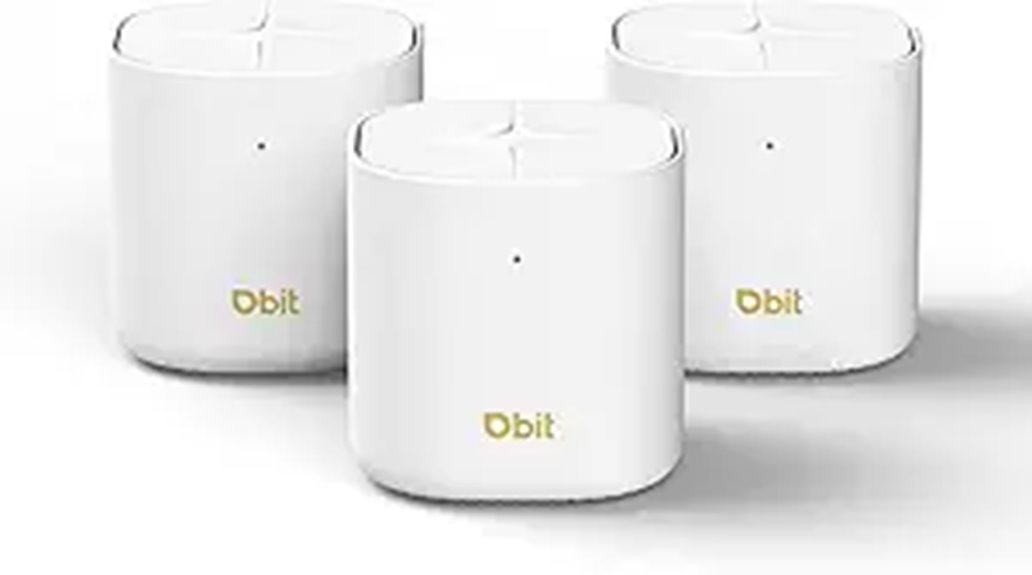
The DBIT AX1800 Mesh Wi-Fi System (D-MAX5, 3-Pack) is an excellent choice for large homes or multi-story buildings that demand reliable, high-speed connectivity. It offers dual-band AX1800 speeds, supporting activities like 4K streaming, gaming, and large downloads without lag. Covering up to 6,500 sq. ft., it replaces traditional routers and extenders, with expandable nodes for outdoor or complex layouts. Each unit has 2 Gigabit Ethernet ports, ensuring stable wired connections. Easy to set up via app or web GUI, it supports multiple devices, advanced security, parental controls, and seamless coverage, making it ideal for demanding households.
Best For: households or multi-story homes requiring reliable, high-speed Wi-Fi coverage across large areas with multiple devices and demanding activities.
Pros:
- Seamless coverage up to 6,500 sq. ft. with expandable nodes for outdoor or complex layouts
- Supports dual-band AX1800 speeds up to 1.8 Gbps, ideal for 4K streaming, gaming, and large downloads
- Includes 6 Gigabit Ethernet ports for stable wired connections and easy setup via app or web GUI
Cons:
- Slightly larger dimensions may require strategic placement in certain spaces
- Requires a compatible app or web interface for setup, which may be less straightforward for some users
- As a mesh system, additional nodes are needed for larger or more complex layouts, increasing overall cost
Tenda Nova Mesh WiFi System MW6
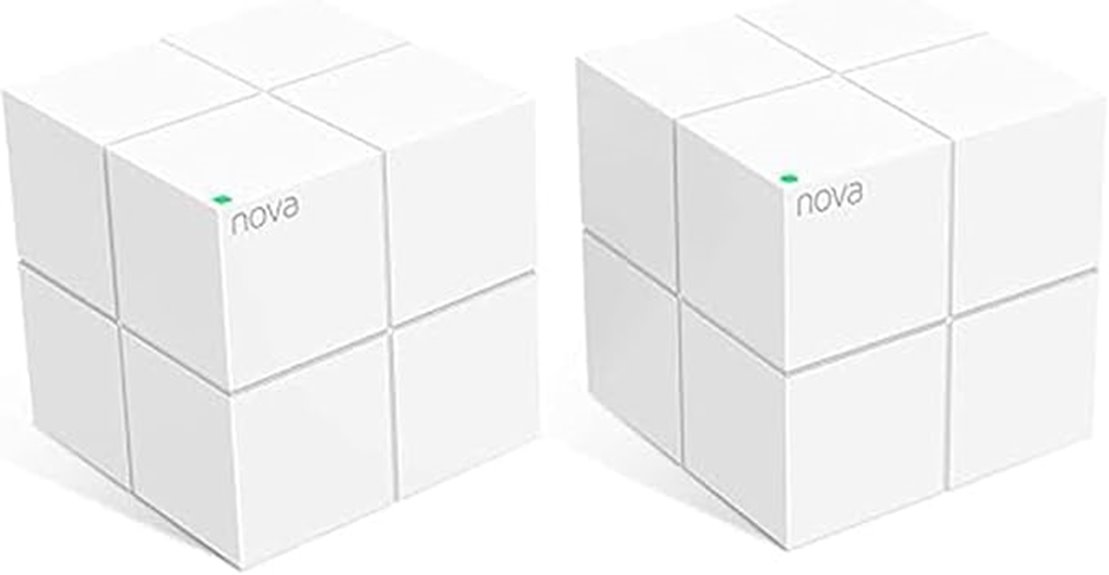
Looking for a reliable mesh Wi-Fi system that covers large homes without the hassle of dead zones? The Tenda Nova Mesh WiFi System MW6 offers up to 4,000 sq.ft. of coverage, making it perfect for replacing traditional routers and extenders. Its 2-pack system covers around 2,400 sq.ft., ensuring seamless roaming with a single network name and password. Powered by MU-MIMO and Beamforming tech, it supports up to 90 devices with fast, stable AC1200 dual-band Wi-Fi. Easy to set up via the Tenda app, it also includes security features like WPA2 encryption and guest networks, providing a simple, secure, and scalable home network solution.
Best For: those seeking a large-scale, reliable, and easy-to-manage mesh Wi-Fi system to eliminate dead zones and support multiple devices in a spacious home.
Pros:
- Covers up to 4,000 sq.ft. with a 2-pack system, ideal for large homes
- Supports up to 90 devices simultaneously with fast, stable AC1200 dual-band Wi-Fi
- Easy setup and management via the Tenda app, with simple node addition
Cons:
- May require additional nodes for even larger coverage beyond 4,000 sq.ft.
- Limited to WPA2-PSK encryption, which may lack some advanced security features
- Slightly higher cost compared to traditional routers and extenders
Netgear Nighthawk Whole Home Mesh WiFi 6 System, 3-Pack , BLK (Renewed)

If you need reliable, high-speed Wi-Fi coverage for a medium to large home, the Netgear Nighthawk Whole Home Mesh WiFi 6 System is an excellent choice, especially with its support for up to 25 devices simultaneously. This 3-pack offers speeds up to 1.8Gbps, perfect for HD streaming, gaming, and video calls. Using Wi-Fi 6 technology, it delivers 1.5 times more capacity and incorporates OFDMA for smoother bandwidth sharing. With coverage up to 4,500 sq. ft., it guarantees seamless connectivity across multiple rooms and floors. As a renewed unit, it provides a cost-effective, reliable solution for creating a robust mesh network in your home.
Best For: households in need of reliable, high-speed Wi-Fi coverage for multiple devices across medium to large homes up to 4,500 sq. ft., supporting HD streaming, gaming, and video calls.
Pros:
- Supports up to 25 devices simultaneously for seamless connectivity
- Fast speeds up to 1.8Gbps ideal for HD streaming and gaming
- Incorporates Wi-Fi 6 technology with OFDMA for enhanced bandwidth sharing
Cons:
- Being a renewed (certified pre-owned) product, it may have limited warranty or wear from previous use
- Setup can be complex for users unfamiliar with mesh networking systems
- May be more expensive than traditional routers for small households with fewer devices
Hitron MoCA 2.5 Network Adapter (2-Pack)
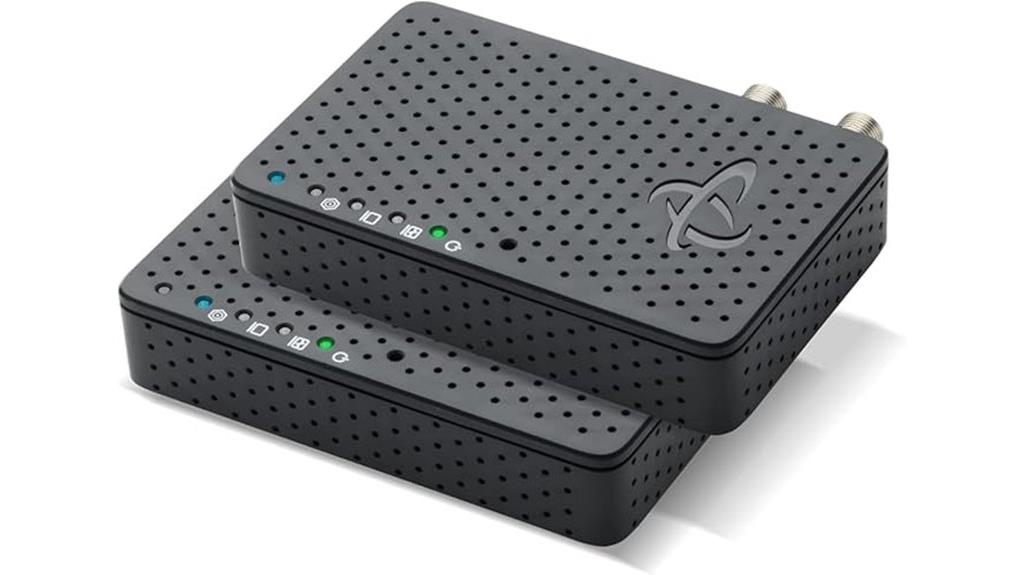
For anyone seeking a reliable way to extend wired network connectivity without installing new Ethernet cables, the Hitron MoCA 2.5 Network Adapter (2-Pack) offers an excellent solution. It transforms existing coax cables into Ethernet links with speeds up to 1 Gbps, perfect for streaming, gaming, or remote work. These adapters are compatible with homes where coax outlets connect to the same central splitter, but not with satellite TV or certain fiber setups. Easy to install, they provide stable, low-latency connections around 3ms, ensuring smooth performance. Designed by a trusted manufacturer, they’re tested for interference-free operation, making them a smart addition to any high-speed, wired home network.
Best For: those seeking a reliable, high-speed wired network extension using existing coax cables without installing new Ethernet runs, ideal for streaming, gaming, and remote work.
Pros:
- Transforms existing coax into Ethernet connections with speeds up to 1 Gbps (HTEM4) or 2.5 Gbps (HTEM5)
- Easy to install and compatible with homes where coax outlets connect to the same central splitter
- Provides stable, low-latency connections around 3ms, suitable for gaming and streaming
Cons:
- Not compatible with satellite TV systems, AT&T Internet, or U-verse due to frequency overlaps
- Requires existing coax setup and does not provide internet service or WiFi
- Mixing different MoCA versions (HTEM4 and HTEM5) may limit maximum speeds
Factors to Consider When Choosing Ethernet Backhaul Mesh Wi‑Fi Kits

When selecting an Ethernet backhaul mesh Wi-Fi kit, I consider several key factors to guarantee it meets my needs. Things like the number of Ethernet ports, the type of backhaul technology, and the coverage area are vital. Additionally, I look at device compatibility and connection speed options to make sure everything works smoothly and efficiently.
Ethernet Port Count
Ever wonder how many wired devices you can connect directly to your mesh Wi-Fi system? The Ethernet port count on each node is key. More ports mean you can connect more wired devices directly, ensuring faster, more stable connections for things like smart TVs, gaming consoles, or office equipment. Most mesh systems offer at least two Ethernet ports per node, allowing for wired backhaul and device connections at the same time. Some advanced kits go further, providing four or more ports per unit, making it easier to expand your wired network. This flexibility is especially valuable in larger homes or offices with multiple wired devices, helping reduce Wi-Fi congestion and ensuring high-speed, reliable connectivity where you need it most.
Backhaul Technology Type
Choosing the right backhaul technology is key to maximizing your mesh Wi-Fi system’s performance. Ethernet backhaul uses wired connections between nodes, offering a stable, high-speed link that reduces wireless congestion. It supports gigabit speeds, making it perfect for demanding activities like 4K streaming and online gaming. Ethernet backhaul also minimizes latency and packet loss, ensuring smoother, more reliable performance. While installing Ethernet cabling may require extra effort, the improved stability and speed are worth it. Many mesh systems feature dual or multiple Ethernet ports per node, giving you flexibility to connect various devices and expand your network easily. Overall, Ethernet backhaul provides a dependable backbone that enhances your mesh Wi-Fi’s consistency, making it an excellent choice for those seeking top-tier performance.
Coverage Area Size
To select the right Ethernet backhaul mesh Wi-Fi kit, I first consider the total square footage of my space. Knowing my home’s size helps me choose a system with enough coverage to eliminate dead zones. For larger homes or multi-floor buildings, I look for kits that cover over 5,000 square feet, sometimes up to 7,200 sq.ft., depending on my needs. It’s important to check each kit’s specifications because coverage varies widely. I also think about whether I might need additional nodes or extenders to reach every corner, especially in sprawling or multi-story layouts. Ensuring the system’s coverage capacity matches my property size is *vital* for maintaining reliable, seamless Wi-Fi throughout my entire space.
Device Compatibility
When selecting an Ethernet mesh Wi-Fi system, confirming device compatibility guarantees everything works smoothly. First, ensure the system supports Ethernet backhaul to leverage wired connections for better performance and lower latency. Check that all mesh nodes and extenders are compatible with Ethernet backhaul to avoid connectivity issues. It’s also vital that the Ethernet ports support Gigabit or higher speeds to handle high-bandwidth activities without bottlenecks. If your home lacks Ethernet wiring, see if the system supports Ethernet backhaul over existing wiring like MoCA or Powerline adapters. Lastly, verify that the mesh kit integrates well with your current network infrastructure and internet provider, guaranteeing seamless setup and reliable operation. Proper compatibility prevents surprises and maximizes your Wi-Fi investment.
Connection Speed Options
The speed of your Ethernet backhaul plays a crucial role in overall network performance, especially as more devices demand higher bandwidth. Ethernet backhaul options generally support speeds from 1 Gbps up to 2.5 Gbps, depending on the cables and adapters used. Choosing a multi-gigabit backhaul like 2.5 Gbps helps minimize bottlenecks and future-proofs your network for faster internet plans. Keep in mind, the actual speed can be limited by cable quality, splitters, and device compatibility. To guarantee smooth performance, your backhaul speed should match or exceed your internet service speed, preventing slowdowns and congestion. Prioritizing higher-speed options guarantees a more reliable, seamless experience across all connected devices, especially in busy or high-bandwidth environments.
Setup Complexity Level
Choosing the right Ethernet backhaul mesh Wi-Fi kit depends heavily on how much setup complexity you’re willing to handle. Some kits are truly plug-and-play, with mobile apps guiding you step-by-step, making installation quick and straightforward. Others require manual configuration, like adjusting IP addresses or connecting additional hardware such as splitters or adapters, which can be more challenging. Kits with auto-configuration features tend to save time and reduce the need for technical skills, making setup accessible for most users. On the other hand, more complex systems might demand a deeper understanding of networking or extra support resources. Your choice should consider your comfort level with technical tasks and whether you prefer a simple setup or don’t mind a more involved process for potentially more customizable performance.
Security Features Offered
Are security features a top priority for your mesh Wi-Fi setup? If so, you’ll want to look for kits that offer robust protections like WPA3 encryption, SPI firewalls, and DoS attack prevention. Many options include parental controls and guest networks, giving you control over access and monitoring device activity. Firmware updates from manufacturers are essential, as they patch vulnerabilities and keep your system protected. Advanced options such as device isolation and authentication help prevent unauthorized access to sensitive data. Compatibility with existing security protocols ensures seamless integration into your current infrastructure. Prioritizing these features helps safeguard your network from cyber threats, keeps your personal data protected, and provides peace of mind knowing your connected devices are secure.
Expandability Potential
When selecting a mesh Wi-Fi system, considering how well it can grow with your needs is just as important as its current capabilities. A good system should support adding new nodes or satellites easily, without requiring major reconfiguration. Compatibility with existing hardware and protocols, like Ethernet backhaul, is essential for seamless expansion. The system should allow straightforward integration of new units through wired Ethernet or wireless backhaul, ensuring network stability and speed remain intact. High-quality mesh systems maintain consistent performance and coverage as you expand, avoiding bottlenecks or signal loss. Additionally, user-friendly firmware and management software are critical, making it simple to set up and oversee a larger network over time. Scalability ensures your Wi-Fi stays reliable as your connectivity demands grow.
Frequently Asked Questions
How Does Ethernet Backhaul Improve Mesh Wi-Fi Performance?
Ethernet backhaul boosts mesh Wi-Fi performance by providing a dedicated, wired connection between routers and nodes, reducing wireless congestion and interference. This setup guarantees faster, more stable data transfer, especially over long distances or in crowded environments. I’ve found that it minimizes lag and buffering, giving me seamless streaming, gaming, and browsing experiences. Overall, Ethernet backhaul makes my mesh network more reliable and efficient, even when multiple devices are connected.
Can I Upgrade Existing Mesh Systems With Ethernet Backhaul?
Absolutely, you can upgrade your existing mesh system with Ethernet backhaul. Think of it as giving your network a turbo boost—by connecting nodes via Ethernet, you reduce interference and increase stability. I’ve done it myself, and the improvement is noticeable. Just check if your current system supports Ethernet backhaul or if you might need a firmware update. It’s a game-changer for seamless, reliable Wi-Fi throughout your home.
What Are the Compatibility Requirements for Ethernet Backhaul Kits?
Ethernet backhaul kits need compatible ports and standards to work seamlessly. I check that my router and mesh nodes support Gigabit Ethernet and have available Ethernet ports. I also guarantee the devices follow the same networking standards, like Wi-Fi 6 or Wi-Fi 5, for peak performance. Compatibility is key, so I always verify manufacturer specs and look for models explicitly designed to work with Ethernet backhaul to avoid issues.
Is Ethernet Backhaul Necessary for Large or Multi-Story Homes?
Honestly, if you live in a castle or a multi-story mansion, Ethernet backhaul isn’t just nice, it’s essential—unless you like fighting Wi-Fi dead zones like a tech knight. Without it, your signals might stumble and tumble through walls, leaving you buffering during your favorite show. So yes, for sprawling homes, Ethernet backhaul is the secret weapon for seamless, dependable coverage that won’t leave you hanging.
How Do Ethernet Backhaul Options Impact Overall Network Security?
Ethernet backhaul options can considerably enhance my network security. By using wired connections, I reduce the risk of interference and unauthorized access that can occur with wireless links. Plus, a wired backhaul isolates my main network from potential threats on the mesh nodes, making it harder for hackers to intercept data. Overall, it gives me peace of mind knowing my home network is more secure and reliable.
Conclusion
Remember, a chain is only as strong as its weakest link. When choosing your Ethernet backhaul mesh Wi-Fi kit, prioritize the system’s reliability, coverage, and compatibility. Investing in a quality setup now guarantees seamless, hassle-free connectivity for years to come. Don’t settle for less—after all, a well-connected home is a happy home. Stay smart, choose wisely, and enjoy the uninterrupted internet experience you deserve.









